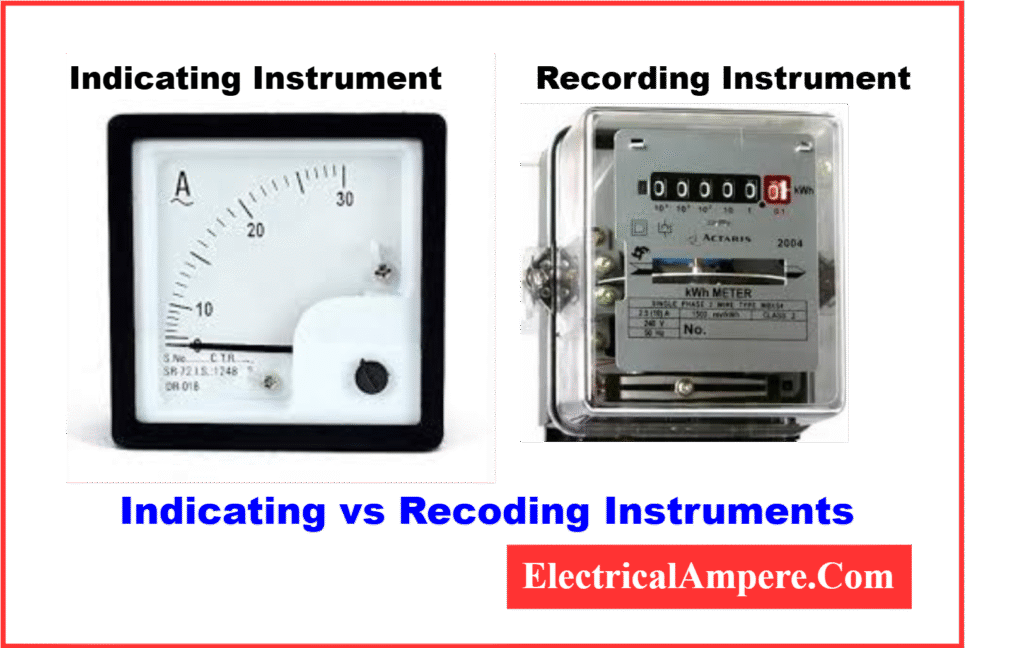Understanding the difference between indicating and recording instruments is essential in the field of electrical and electronic engineering. These instruments are used to detect, display, and sometimes record physical quantities such as voltage, current, power, and energy. Among the various types of measuring instruments, indicating and recording instruments serve unique roles in measurement and monitoring tasks.
Understanding the key differences between them helps in selecting the right tool for specific applications. In this article, we’ll explore both types in detail and provide a comprehensive comparison.
What is an Indicating Instrument?
An indicating instrument is a type of electrical measuring device that displays the instantaneous value of a quantity at the time of measurement. These instruments typically use a pointer and a calibrated scale to indicate the measured value.
Key Features
- Real-time display of measurements
- Requires human observation to read the value
- Common examples: ammeter, voltmeter, wattmeter, galvanometer
Use Case
Indicating instruments are ideal for instantaneous monitoring in labs, electrical panels, or field testing.
What is a Recording Instrument?
A recording instrument not only measures but also records the variation of the measured quantity over a specific period. This is crucial for analysis, diagnostics, and historical reference.
These instruments typically record data using either graph paper with ink pens or digital memory systems.
Key Features
- Continuous data recording
- Useful for long-term monitoring and data logging
- Common examples: energy meter, ECG machine, graphical temperature recorders
Use Case:
Recording instruments are widely used in industrial automation, medical diagnostics, and research environments where historical data is vital.
Comparison: Indicating vs. Recording Instruments
Here is a side-by-side comparison table that outlines the differences between indicating and recording instruments:

| Aspect | Indicating Instruments | Recording Instruments |
|---|---|---|
| Function | Display the current value of a measured quantity | Record the variation of a quantity over time |
| Observation | Requires manual observation | Works independently of observer |
| Display Mechanism | Pointer on a calibrated scale | Ink pen on chart paper or digital display |
| Power Consumption | Lower | Higher due to recording mechanism |
| Parallax Error | Possible due to manual reading | No parallax error |
| Waveform Display | Cannot display waveforms | Capable of waveform representation |
| Construction | Simple and compact | Complex and bulky |
| Damping Requirement | Normal damping sufficient | Requires additional damping |
| Torque Requirement | Less operating torque needed | Higher torque needed for extra components |
| Effect of Environment | More sensitive to environmental changes | Relatively less affected |
| Maintenance Cost | Low | Higher due to ink, paper, or digital memory |
| Examples | Ammeter, Voltmeter, Galvanometer | Energy Meter, ECG Machine, Thermoscope |
| Cost | Economical | Comparatively expensive |
| Data Storage | No storage capability | Stores data for analysis |
| Usage | Quick checks and routine readings | Detailed analysis and monitoring |
Table showing difference between indicating and recording instruments.
Summary: Which One Should You Use?
| Choose Indicating Instruments When: |
|---|
| ✔ You need quick real-time readings |
| ✔ Continuous data storage isn’t necessary |
| ✔ You want a simple, low-cost solution |
| Choose Recording Instruments When: |
|---|
| ✔ You need to monitor changes over time |
| ✔ You require permanent records for analysis or audits |
| ✔ Accuracy and historical data are crucial |
Conclusion
The main difference between indicating and recording instruments lies in how they present the measured data.
- Indicating instruments give you an immediate reading, best suited for momentary assessments.
- Recording instruments provide a time-based graphical or digital record, perfect for analysis, diagnostics, or future reference.
Understanding their roles ensures optimal instrument selection for your electrical and electronic measurement needs.
FAQs
An indicating instrument displays the real-time value of a measured electrical quantity, such as voltage or current, using a pointer and a calibrated scale. It requires manual observation.
Recording instruments are used in industries, laboratories, and medical diagnostics to track and store data over time for analysis, monitoring, and reporting.
ndicating instruments show instant values on a scale, requiring observation. Recording instruments continuously log data over time for later analysis, often without user presence.
Examples of indicating instruments include ammeter, voltmeter, wattmeter, and galvanometer. Examples of recording instruments include energy meter, ECG machine, thermoscope, and graphical temperature recorder.
Related Articles: